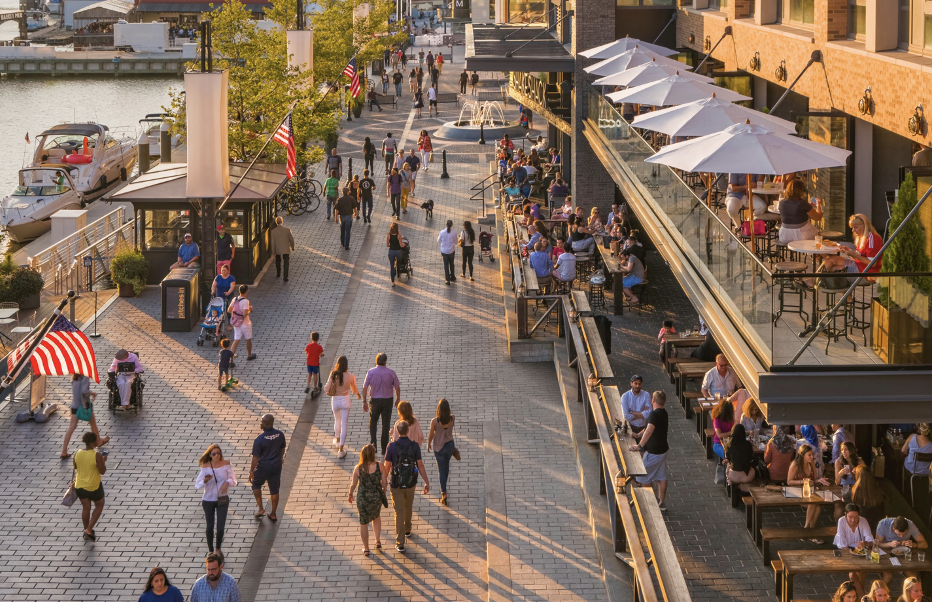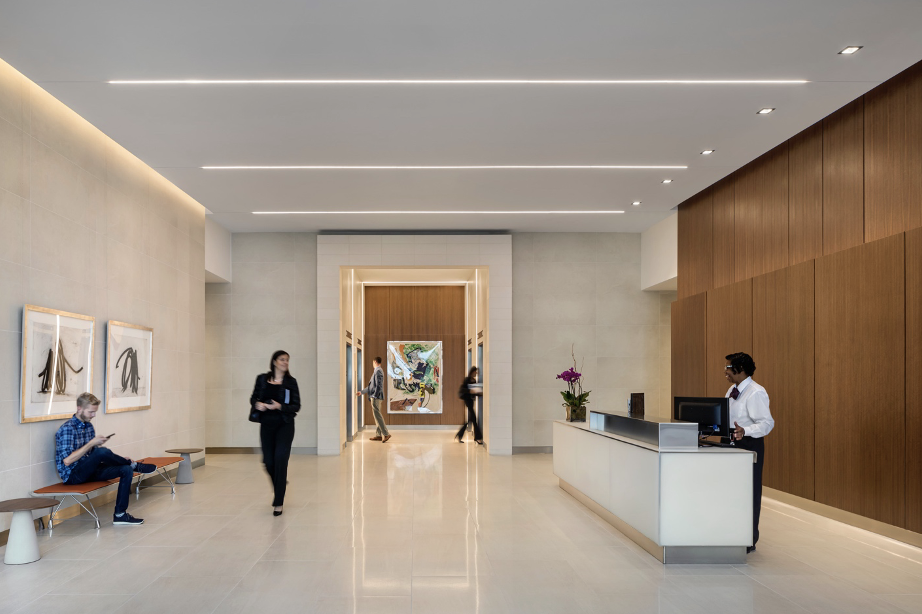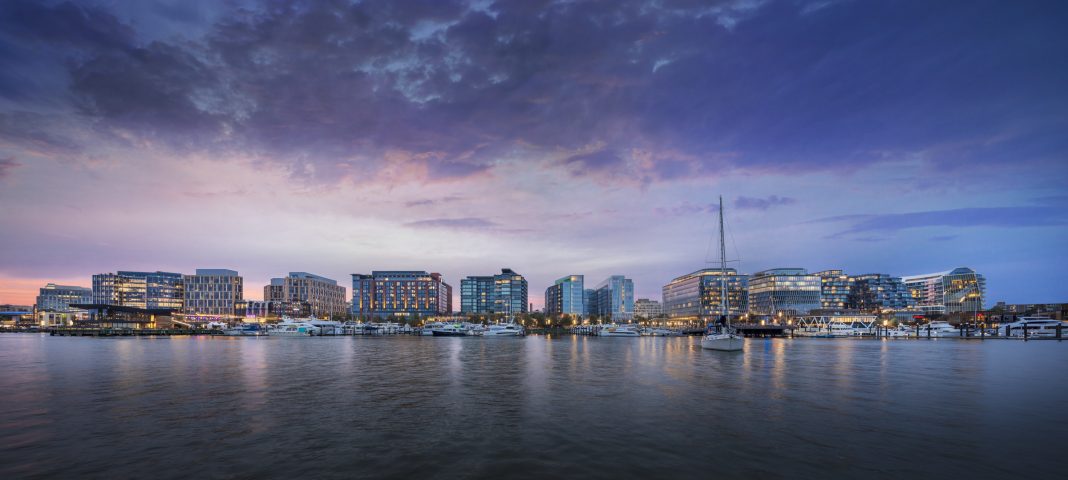Barbara Mullenex AIA, Principal and Executive Director of Perkins Eastman, says that commercial real estate is at an inflection point. City planning, policy, design, and big thinking can bring it back better than ever.
The commercial real estate market, particularly the office sector, is in an unprecedented position. In Washington, D.C., where I do much of my work, office vacancy rates are approaching 21% more than three years after many knowledge workers abruptly started working from home. Given the city’s substantial residential shortage, there are those in the media and politics who question why we can’t just turn unused office space into multi-family housing; but from a code, engineering, and design perspective, that’s a much more difficult proposition than one might initially think. In fact, according to the National Bureau of Economic Research, only 11% of office buildings are suitable to be converted to residential use.
But, it’s not all doom and gloom.
Commercial real estate is not dead. Nor is it dying. It’s changing. Truly, we are at an inflection point. We can’t skip past it. We must go through it.
And use creativity, ingenuity, and design to get us to a better place than where we started by rethinking how 21st-century cities can function in a more holistic way. Here’s how.
A More Fluid Model for Commercial Office
It seems hard to believe at times, but it has now been three years since most knowledge workers packed up their workstations and started working from home. Of course, safety was the first priority for these decisions, but that quickly morphed into other driving motives. Whatever the cause, the fact remains that there have been wide-reaching ramifications and unintended consequences for this move. Many companies across the country are reducing their office square footage, or looking for ways to restructure leases, as they contemplate the long-term impact.
For the time being, we have moved to a much more fluid model for the workplace—away from people in seats from 9-5 and into a structure that allows people to have more autonomy about where and how they work. As a company leader, I see the logic and the appeal. We continue to get productivity from our employees, and they report satisfaction with their work/life balance. So, what’s the problem?
As an urbanist and avowed lover of cities, I know there is more we can do to recapture the vibrancy and energy of urban downtowns. Most American cities from the last century were created in a way that allowed people to live in one place (the suburbs) and work in another (the city). If we can move past that idea and create cities, downtowns, and neighborhoods where people want to live and have access to their offices, open space, fun space, and retail space, it will breathe new life into the commercial real estate market and to the very fabric of our urban environments.

Return to Cities Means Return to Office
In cities built for people to live in one area and work in another, we need high office occupancy and the guaranteed captive audience Monday-Friday, 9-5 to keep transport networks, restaurants, dry cleaners, and other smaller businesses running. Now that we don’t have that influx of people, what do we do? Particularly in cities like Washington, D.C., where many neighborhoods struggle with affordable, market-rate housing, it takes policy changes, urban planning, strong architecture, and a cultural shift.
To make up for a more fluid office model, we need more people to live downtown. With the housing shortage, city living has become less accessible for many people, particularly young families and recent graduates saddled with student loans.
Recently I had the opportunity to work with Muriel Bowser, the Mayor of D.C., on the Downtown Action Plan. Mayor Bowser has very specific goals for getting 15,000 more people to live in Downtown (currently there are about 25,000 people living there, which is only 3.5% of the city’s population). While we’ve explored a range of ideas and solutions, the simple fact is that we need about 7,500-10,000 more residential units at a variety of price points. And that alone will make it easier to get more people back into the office more often, with or without companies mandating it.
But there’s also the messaging component. I still don’t see sustainable living mentioned very much as it pertains to city living and it’s a missed opportunity. Climate change is an issue hitting 20- and 30-somethings the way social justice did for the Baby Boomers. I am continually astounded by the growing numbers of people I see taking their children to school on bikes here in D.C., and the two biggest reasons are the expense of having a car and a drive to reduce carbon emissions.
Living in cities is environmentally friendly. With good urban planning, it can be more convenient as well. And just as affordable as the suburbs. If we make it more attractive in other ways, people will come back. And then they will see the vibrancy, culture and connection that comes with living an urban lifestyle. Even though the last 3+ years have felt isolating, make no mistake: people want to be where the energy is. They want to be with each other. We just have to remind them what they’re missing.

The Success of Rethinking Commercial Real Estate
We have a prime example of strong policy, good design and smart growth converging right on our doorstep—The District Wharf. For those who don’t live near D.C., The Wharf is a planned neighborhood made out of the city’s (formerly) disused waterfront. The project is a public/private partnership with input from countless stakeholders and a major infrastructure investment from the city. We designed it to be not just part of the city but an extension of the city, tying into our well-known grid system and making room for all the things people really love about urban life—a sense of discovery, texture, visual stimulus and an armature of retail, office and residential that just doesn’t exist outside an urban environment. And it’s creating the economic value that brings more residents, which brings more office, which brings more retail and restaurants until you have this self-perpetuating, virtuous cycle of smart growth.
The Wharf has the biggest deals in Washington, D.C. commercial real estate right now. Williams & Connolly, a 300-employee law firm, recently relocated to one of the waterfront office buildings and the knock-on effect has been tremendous. The energy is palpable in a way that has been lost in many urban areas since the pandemic, but it shows us the path forward. For the commercial real estate market to reinvent itself, it has to be part of a much larger urban context.
The success of the Wharf on both commercial office leasing and residential leasing and sales is proof of concept that the 21st century is about obliterating the dated idea of having one district for working and another for living. People want to live work and play in a 24 hour/365 days a year environment. Transforming our dated downtowns to places where people can live, work, and enjoy leisure time is where we have to go, and developers and real estate leaders will need to work hand-in-hand with architects, policymakers and communities to get us there.


